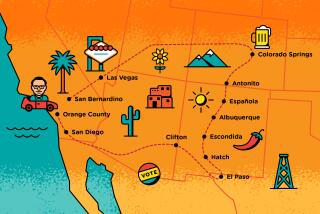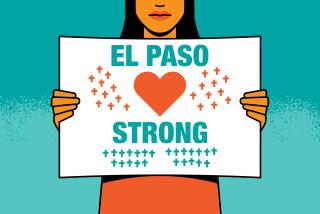Safety Concerns Follow Popular ‘Little Buses’ on the Road
- Share via
HOUSTON — It is nightfall on this city’s mostly Latino east side, and the camionetas are filling up for the evening rush.
Packed inside the aging passenger vans are moms from Morelia headed for Union City, pops from Escondido loaded with presents for children in Tapachula, girlfriends from Harlingen visiting boyfriends in Chicago. Before the night and the next day are out, most of them will be delivered to houses in tiny Mexican pueblos, or apartments, in ethnic enclaves across the United States.
But some passengers still may be on the road, waiting for a driver to replace a tire that blew because it was bald or to fix a radiator that couldn’t take the heat. If it’s a really bad night, a few may end up in hospitals, victims of what public safety experts believe is an inordinate number of crashes involving camionetas. By one estimate, as many as 250 passengers in camionetas and other vans crossing the border are killed every year.
Over the last decade, camionetas, or “little buses,” have become an increasingly popular mode of transport for millions of Latinos living in the United States. But the 9- to 15-passenger vans are poorly regulated in most states. And until now, they have been subject to no federal safety regulations.
Last year, after years of debate, Congress passed legislation directing the U.S. Department of Transportation to apply to camionetas the same safety rules that govern trucks and larger buses. The rules would subject the vans to regular inspections and require drivers to keep maintenance records and logbooks of hours spent on the road.
California already requires vans that carry more than 10 passengers to meet the same safety requirements as buses, but its rules don’t apply to van services based in other states.
Making sure the estimated 14,000 U.S.-based camionetas follow the new rules will be tough. The transportation agency says it has neither the money nor the personnel to regularly inspect them, nor even to verify their safety records. And opposition to expanded regulation is already being heard from taxi, limousine and airport shuttle van operators who do not want the new rules to apply to them.
“The camionetas are like an underground railroad,” said John Hart, a professor of history at the University of Houston, in a city where more than 50 camioneta services compete fiercely for passengers. “They spring up when and where they’re needed, but they disappear just as quickly, and no one’s ever had much luck at penetrating the industry or regulating them.”
While Washington deliberates, camioneta companies are busily taking reservations, lighting candles to saints in their makeshift waiting rooms and luring customers away from Greyhound with promises of free food on the road and ranchero music on the radio.
The popularity of camionetas is understandable: They generally charge less than commercial buses and airlines. Their drivers tend to be Spanish-speaking immigrants like the vast majority of their passengers. And they take their customers, taxi-style, right to their doorsteps.
Once limited mainly to cities and towns along the U.S.-Mexico border, camioneta businesses now ply their trade all over the East Coast, the South and the Pacific Northwest. They are particularly prevalent in Texas, perhaps because so many key routes traverse the state. The American Bus Assn. estimates that 8 million Latinos in the United States ride vans and buses annually, spending more than $200 million. A large chunk of that goes to camionetas.
A Booming Business
Today, successful camioneta services have fleets of vans, their own terminals, toll-free numbers and special rates for frequent travelers. They advertise in Spanish-language newspapers around the country, offering door-to-door service to the places where the jobs are, where the families are.
The North American Free Trade Agreement and the expansion of cross-border commerce have fed the camioneta boom. So have the growing numbers of illegal immigrants living in the United States. They tend to use the camioneta services because they fear a ride on a Greyhound bus would make them more vulnerable to discovery by law enforcement.
Some camioneta owners double as immigrant smugglers, and some smuggle narcotics across the border or from state to state, according to law enforcement agencies in border cities. But U.S. Border Patrol officials and others who track the trade believe that the vast majority are simply in the business of taking people where they want to go.
“I always go on camionetas. They talk your language. They are your people,” Perla Lopez, a 21-year-old student, said midway through a trip from Matamoros, Mexico, to Atlanta to visit a friend. Born in Brownsville, Texas, Lopez lives a cross-border life, staying frequently with relatives in Matamoros and hopping on camionetas to run errands in the United States.
On this particular evening, Lopez and 10 other people passed the hours in a van run by a Houston-based company called Transportes El Mexicano by singing Mexican boleros and sharing tortas. The 1982 Ford van was shabby but clean. A rosary hung from the rearview mirror. At the end of the ride, Lopez stepped out of the van at her friend’s door in Atlanta.
The cost of the trip was $45. On a Greyhound bus, it would have been $59.
The camionetas “play an important role in our community,” said Benito Juarez, deputy director of the American Friends Service Committee, in Houston. The tiny office he works in is flanked on one side by a camioneta business whose big, hand-lettered sign advertises salidas diarias, or daily departures, to Tlaxcala, Reynosa, Altamirano and San Luis Potosi in Mexico as well as stops to Kentucky, Boston, Los Angeles and Philadelphia.
“I think people feel more secure because they know all the people who go and they know where they are going,” Juarez said. “It is precisely because the services are less formal than buses that people like them.”
No comprehensive data exist on the safety of camionetas. The only available statistics were contained in an unscientific study by their acknowledged nemesis, the American Bus Assn.
The association tracked newspaper reports of accidents involving the vans for several years. It came up with an annual average of 250 casualties in van accidents. That compares to an average of fewer than 10 fatalities a year for intercity buses, it said. But the survey lumped camionetas with vans operated by immigrant smugglers and farm labor contractors, and the U.S. Department of Transportation contends the numbers are far from conclusive. The agency has asked Congress for at least a year to study the vans’ safety record.
The safety of the vans has been an issue in Houston since two 1991 accidents involving vans based there killed one person, injured eight and left one comatose. The vans are still subject only to registration under state law.
“The drivers operate unregulated for longer hours than their bus counterparts in vans that endure an enormous amount of wear and tear on a daily basis,” said Lester Mills, coordinator of the vehicle enforcement program for the Texas Department of Public Safety. “But they don’t have to comply with safety regulations, and their passengers pay the price.”
Jose Luis Galves, the owner of Transportes El Mexicano, started his business two years ago after years driving for another camioneta company. The Mexico native has 10 vans and carries passengers to North Carolina, Atlanta, New Jersey, New Mexico and New York.
“It’s a good business, but there’s more and more competition,” Galves said. “We do what we can to compete. We offer them lunch on the road and snacks. I’m thinking about installing a television monitor. . . . Some people like us because we don’t ask questions about where they came from or how they got here. Others like us just because they prefer a van, not a bus.”
The camioneta business is as old as the first Mexican immigrant in the United States who charged his buddies for a ride back home to Morelia or Oaxaca or Mexico City. For decades before NAFTA gave U.S. and Mexican bus operators cross-border access, camionetas were the only cheap, efficient way for Mexicans working in the United States to get back home to their families.
Under federal law, van services are required only to register with the Federal Highway Administration and to maintain insurance coverage.
Strict Rules in California
California regulates the vans more closely than any other state. It subjects any vehicle carrying more than 10 passengers for compensation to the same safety requirements as buses. This year, after several crashes involving vans carrying farm laborers, a new law was passed requiring seat belts and seats in such vans.
But the California regulations apply only to van services based in the state. Vans taking passengers from elsewhere cannot be stopped by the California Highway Patrol unless they have been pulled over for another traffic violation.
“Obviously, there’s a limit to what state law can do when you’re talking about vehicles that travel in from elsewhere,” said CHP spokeswoman Nancy Kramer. “They are not subject to inspection, and the problem is just growing. It’s going to be huge with all the folks going back and forth.”
More to Read
Sign up for Essential California
The most important California stories and recommendations in your inbox every morning.
You may occasionally receive promotional content from the Los Angeles Times.













